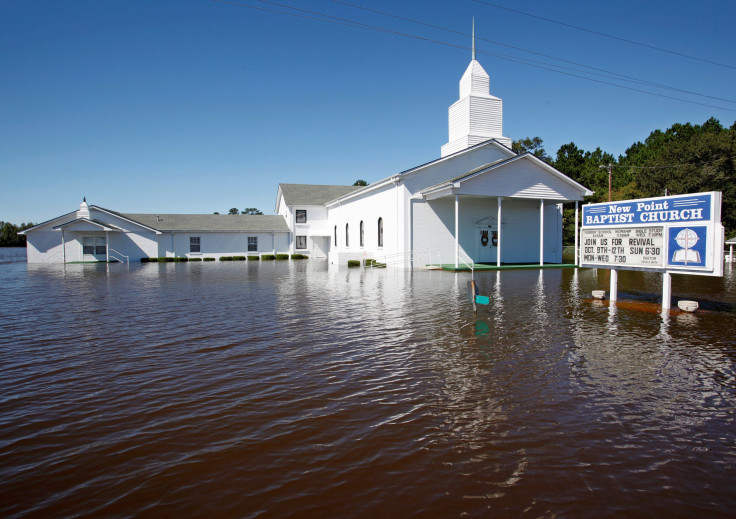Hurricane Matthew: North Carolina Rescues Victims As Storm Heads Out To Sea

Emergency crews in boats rescued hundreds of people from floodwaters and plucked others from rooftops by helicopter in North Carolina as former hurricane Matthew flooded much of the U.S. Southeast before weakening on Sunday and turning out to sea.
Matthew, the most powerful Atlantic storm since 2007, was downgraded to a post-tropical cyclone on Sunday after its rampage through the Caribbean killed nearly 900 people in Haiti. In the United States, 17 people died and more than 2 million U.S. homes and business had lost power.
The storm continued moving out to sea, according to the National Hurricane Center's 2 p.m.(1800 GMT) report, which placed the center of the storm about 150 miles (240 km) off the coast of Cape Hatteras, North Carolina.
Although Matthew lost its tropical characteristics, the storm still packed hurricane force winds as far as 70 miles (110 km) from the center and tropical-storm-force winds 240 miles (390 km) away.
The U.S. Federal Emergency Management Agency (FEMA) sounded warnings about flash floods, the leading cause of weather-related deaths.
Officials said many coastal and inland communities were still under water, either from coastal storm surge or overrun rivers and creeks, and dangerous conditions existed from downed power lines and damaged homes.
U.S. President Barack Obama declared a state of emergency in Georgia and Florida, freeing up federal money to help the states repair damaged infrastructure and remove debris.
In North Carolina, where at least eight people died, Governor Pat McCrory pleaded for outside help, asking the country not to be too distracted by the U.S. presidential campaign, currently transfixed by a 2005 video of Republican nominee Donald Trump making vulgar comments about women.
"We need your help," McCrory said.
Florida reported five storm-related deaths, Georgia three and South Carolina one.
McCrory said 334 rescue workers risked their lives carrying out 877 rescues overnight.
"These rescue teams, I've got to let you know, they are extremely exhausted at this time," McCrory said.
In one of the dramatic rescues in North Carolina, out-of-state firefighters helped save three people from the roof of an SUV in inland Cumberland County, where more than 500 rescues took place.
Flash flooding turned a creek into a "roaring, raging river" that swept the vehicle off the roadway on Saturday night, said Battalion Chief Joe Downey of the Fire Department of New York. He was part of a team from three states that carried out 64 rescues on Saturday night and Sunday morning.
"Water was almost up to the roof of the SUV," Downey said in a telephone interview. "It was bad. They had nowhere to go."
McCrory also told of seeing video of the Coast Guard rescuing several people from a roof by helicopter, adding, "I hope that dog survives, too."
He reported at least one other helicopter rescue where boats could not reach the home. In Florence County, South Carolina, a vehicle trying to cross a flooded roadway was swept away by flood waters, killing one person, Governor Nikki Haley said.
Elsewhere in the state, coastal officials asked evacuees to wait to return and Charleston residents raked out storm drains and cleared debris near their homes, while local officials navigated rivers and combed though neighborhoods looking for damages power lines and downed trees in roadways.
In Virginia, where more than 300,000 customers had lost power, the city of Norfolk declared a state of emergency and urged its citizens to remain off the road, while the city of Virginia Beach closed all parks, recreation centers, libraries and the Virginia Aquarium.
© Copyright Thomson Reuters {{Year}}. All rights reserved.





















